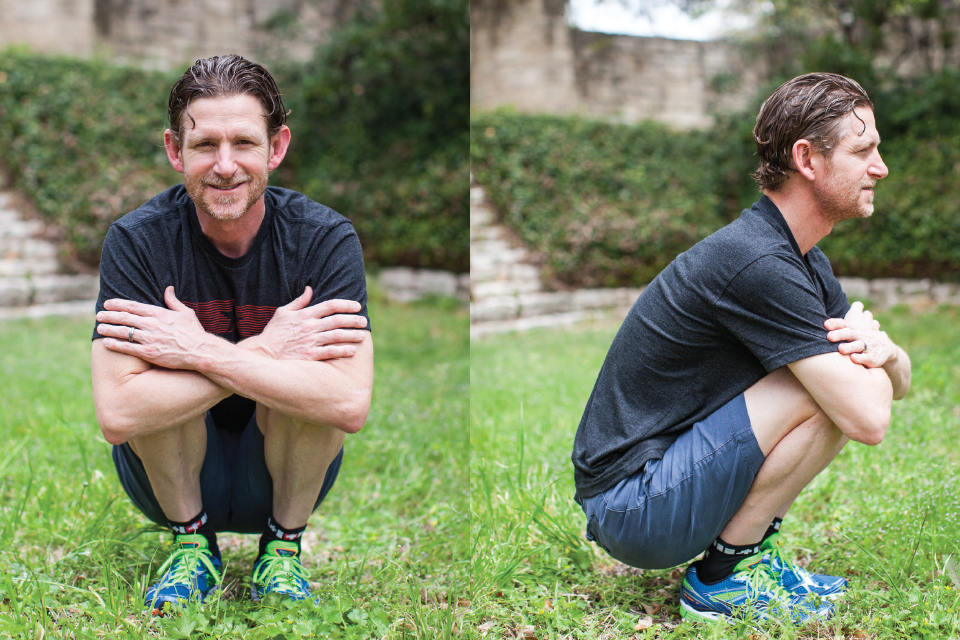Why You Need To Be Able To Squat

Squatting is at once a simple and complex movement. It is a functional movement—squatting is basic and evident in human movement from the time we begin to stand. Toddlers can squat with ease.
In some cultures it is more common for friends to converse, have tea, play games, or work while in a full squat position than sitting in a chair or on the ground. In many places, toilet openings are built directly into the ground rather than raised, meaning—that’s right—users have to be able to squat.
Go ahead; try it. A full squat means heels are on the ground and legs close together, with the ability to drop the tailbone all the way down to the heels. There should be minimal muscle activity at the bottom of the squat; the back should be rounded, and hanging out in this position for some time—without tipping over backwards—should be possible. Why is squatting so complex? Much is required of the body to allow this to happen, and there are many reasons why it may not be possible.
The ability to perform a full squat reflects a balanced and mobile pelvis, one that is able to transition out of the common anteriorly tilted position (that creates a deep, lordotic low back curve) and into a more posterior position (or lumbar flexion). It also demonstrates the ability to efficiently turn off or relax commonly over-active muscle groups, such as the hip flexors, back extensors, quadriceps, and calves. And being able to hold the position for any length of time is only possible if one can breathe into and expand the back of the chest wall using the diaphragm properly.
In sum, being able to fully squat means that the squatter can fully flex through the entire body, an ability that many believe is seriously lacking in modern-day society.
When Squatting is Difficult
Overdevelopment or overuse of the aforementioned muscle groups (hip flexors, back extensors, quadriceps, and calves) leads to postural changes that inhibit the ability to flex. One reason is that sitting and standing too upright with a forwardly tilted pelvis create hip flexors and back extensors that are too tight. Another reason is shallow breathing patterns or hyperventilation. And traditional weightlifting techniques (such as Olympic-style squats and power cleans, deadlifts, and lat pull-downs) have a tendency to place too great an emphasis on these muscle groups. Becoming too strong in these muscle groups while not countering with thoughtful training of opposite muscle groups and in multi-directional planes of movement can lead to serious movement impairments.
Quadriceps can easily become overdeveloped, especially when not enough work is done to strengthen the opposing muscle groups, the hamstrings, and gluteals. Quadriceps straighten the knees and pull the pelvis forward. To efficiently squat, the knees need to freely bend and the pelvis needs to rock back. Short quads that don’t relax fully will surely prevent a full squat.
Tight calves can develop for many reasons, but a big one is modern footwear with an elevated heel. Habitually elevating the heel will lead to tightness of the calves. This in turn will limit the ability to dorsiflex the ankle (the reverse of pointing the foot down), a key component of a full squat. Chronically tight calf muscles are usually the main reason that my patients may not eventually be able to perform a full squat, since a lifetime of short, tight calves may not be completely reversible.
Being able to fully squat is a goal that I set with most of my patients. At their initial exam, I find that only about 20-30 percent can do a full squat properly. For the record, I measure with shoes on and recognize that a typical running shoe with an 8-12 millimeter heel to midfoot drop will help a lot by unloading tight calf musculature. Is 20-30 percent a reflection of societal norms? Probably not, but these are people with musculoskeletal problems seeking treatment for issues that may be directly related to their inability to get into a position like this.
Why Squat?
My patients need to be able to squat because the position reflects a mobile, adaptable, and healthy musculoskeletal system. Let’s take the example of a cyclist with lower back pain after riding. A good riding position places the back in a sloping, rounded position from hips to neck. The position mimics the position of the hips and spine while performing a full squat. While riding at mild to moderate efforts, there should be minimal back muscle activity. But if the back starts to arch and the pelvis rolls forward, the back muscles become overused, strained, and eventually painful.
Cyclists do this for all of the reasons previously mentioned. They may also use their back muscles because they don’t know how to counter by using their abdominals. They may overuse their hip flexors because they can’t oppose them with strong hamstrings and gluteals. They may pedal with toes heavily pointed down because their calves are strong and short. And (most likely) they simply can’t breathe well when they round their back. So when this high aerobic activity demands more and more oxygen, cyclists tend to flatten their back to excessively open up the belly for breathing.
Inability to round the back and flex hips, knees, and ankles will ultimately affect body position. Practicing squatting can help. This normal activity reflects an ability to assume many positions in sport and daily life without compensation and strain and enables efficient breathing without the need for assistance from back and neck muscles.
So try it. You may be surprised.






